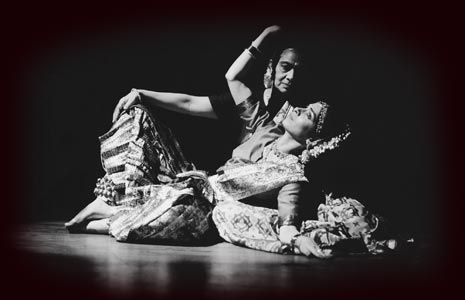
THE CHOREOGRAPHER AND STYLE
TMDC is known for its signature presentations: starting with dances from its Classical Bharatanatyam repertoire, it steps forward with its “Bridging items”, and then moves to the Contemporary work.
Choreographer/dancer Tehreema Mitha, born and brought up in Pakistan, was trained in the Classical style of Bharatanatyam by her mother/Guru, Indu Mitha. Dancing from the age of seven, she performed her Arangatram in 1986 (during Pakistan’s most culturally repressed era) and also began to choreograph in that year. She holds a BA degree in Philosophy and English Literature and an MA in Fine Arts. In 1990 Tehreema Mitha launched into a full time professional dance career, giving solo two hour performances and then full evening presentations with her company in Pakistan: Tehreema Aabvaan Dance Productions 1993 to 1997, while also teaching dance to adults and children. She produced her first Contemporary item in 1990. In 1997 she moved to the United States seeking to choreograph with more freedom.
Her Classical items are different to the traditional Bharatanatyam. While adhering strictly to the Kalakeshetra technique, she continues in the footsteps of her Guru, Indu Mitha, who developed a specific style in the early fifties, using North Indian music as accompaniment to this South Indian dance form. Moving away from Hindu Mythology, Tehreema imbues her choreography with universal themes of love and lore.
Mitha’s bridging dances span the gap between the centuries, maintaining the classical form yet presenting it in a contemporary format.
As for the Contemporary style, it is all her own. Breaking away from the strictures of the classical there is more freedom of movement and a variety of topics that touch on literature, science, philosophy and our everyday lives; the joys and complications, confusion and despair of our modern times.
This emotionally charged and theatrical Contemporary style stands in sharp contrast to the classical items, yet at the same time it echoes the culture it originates from.
Seeing both styles on the stage in the same evening shows the progression of a generation unwilling to leave its past behind, and while respecting it, moving forward with no loss of identity.
As the choreographer says,
“ My work is not fusion. It is what we are today; now. I refuse to be tidily slotted and labeled as: “Ethnic”, “Oriental” or “Traditional” South Asian dance. We are part of a dynamic ever changing World Culture in which, if we do not lose our roots and sense of self, we can discover so much more”.
THE MUSIC
The music for each item is especially composed in a process of fine collaboration between the choreographer and musicians. While the choreographer holds the threads of the rhythms, timing, the changes and twists and turns of the piece in her hand, each musician (an artist of the highest caliber in his own art) weaves his/her expertise into the fabric of the piece completing the vision. Thus every piece is complexly and finely interlinked as an essential part of the dance, not a separate application.
Tehreema Mitha has had the honor to work with the finest musicians and vocalists both in and from Pakistan, from India and in Greater Washington DC area.
While the music is based on classical eastern ragas and rhythms, for many items folk instruments and instruments from other cultures, e.g. The Spanish guitar, saxophone, the piano, have also been included when appropriate for Contemporary items.
WHERE IT ALL BEGAN
Guru Indu Mitha (née Chatterji) was trained in the Uday Shankar style by Zohra and Kameshwan Sehgal at Lahore, during her high-school years. She then turned to Bharatanatyam, initially at Sangeet Bharrati, Delhi, with Vijay Raghava Rao, later taking private lessons in Madras from Shrimati Lalita Shastri (of Kalakeshetra, Adyar).
Having moved to Pakistan when she married after the partition of the Indian sub-continent, these lessons were resumed through the years till 1971 whenever Indu visited her parents in Delhi, as a loving gift to her pupil by Lalitaji. Indu graduated with her MA (Philosophy) from Delhi University in 1951, and taught at the Government College for Women, Rawalpindi.
However, since 1953, her main focus has been dance, which she taught and staged in one form or another to the present day. As a dancer/ choreographer, she has developed a style of Bharatanatyam all her very own. She has written, directed and received national awards for "historical musicals" with high school students and has produced a number of dance dramas as well as solo items, some of them with her daughter and disciple, Tehreema Mitha. Now 75, Indu Mitha continues to teach dance in Pakistan. |